
A cable-stayed bridge has one or more towers, from which cables support the bridge deck. A distinctive feature are the cables or stays, which run directly from the tower to the deck, normally forming a fan-like pattern or a series of parallel lines. This is in contrast to the modern suspension bridge, where the cables supporting the deck are suspended vertically from the main cable, anchored at both ends of the bridge and running between the towers. The cable-stayed bridge is optimal for spans longer than cantilever bridges and shorter than suspension bridges. This is the range within which cantilever bridges would rapidly grow heavier, and suspension bridge cabling would be more costly.

The Millau Viaduct is a multispan cable-stayed bridge completed in 2004 across the gorge valley of the Tarn near Millau in the Aveyron department in the Occitanie Region, in Southern France. The design team was led by engineer Michel Virlogeux and English architect Norman Foster. As of October 2023, it is the tallest bridge in the world, having a structural height of 336.4 metres (1,104 ft).

Reliance Infrastructure Limited (R-Infra), formerly Reliance Energy Limited (REL) and Bombay Suburban Electric Supply (BSES), is an Indian private sector enterprise involved in power generation, infrastructure, construction and defence. It is part of the Reliance Anil Dhirubhai Ambani Group. The company is headed by its chairman, Anil Ambani, and chief executive officer, Punit Narendra Garg. The corporate headquarters is in Navi Mumbai. Reliance Infrastructure's interests are in the fields of power plants, metro rail, airports, bridges, toll roads, and defence. It is a major shareholder in the other group company, Reliance Power and Reliance Naval and Engineering Limited.

The Kap Shui Mun Bridge (KSMB) in Hong Kong, part of Lantau Link of Route 8, is one of the longest cable-stayed bridges in the world that transports both road and railway traffic, with the upper deck used for motor vehicles and the lower deck for both vehicles and the MTR. It has a main span of 430 metres (1,410 ft) and an overall length of 750 metres (2,460 ft). It spans the Kap Shui Mun marine channel between Ma Wan and Lantau islands and has a vertical clearance of 47 metres (154 ft) above sea level. The bridge was completed in 1997.
The Western Freeway was a proposed controlled-access highway in Mumbai, India that would stretch from Marine Drive in South Mumbai to Kandivli in the north, a distance of 29 km. The project envisioned the construction of four major sea links over the Arabian Sea along Mumbai's western coastline to reduce traffic-congestion between the Western Suburbs and South Mumbai.

The Bandstand Promenade, also known as Bandra Bandstand is a 1.2 kilometer long walkway along the sea on the western coast of Mumbai, India in the neighborhood of Bandra. It is simultaneously a popular hangout spot, a jogging track and a park.

A segmental bridge is a bridge built in short sections, i.e., one piece at a time, as opposed to traditional methods that build a bridge in very large sections. The bridge is made of concrete that is either cast-in-place or precast concrete.

An extradosed bridge employs a structure that combines the main elements of both a prestressed box girder bridge and a cable-stayed bridge. The name comes from the word extrados, the exterior or upper curve of an arch, and refers to how the "stay cables" on an extradosed bridge are not considered as such in the design, but are instead treated as external prestressing tendons deviating upward from the deck. In this concept, they remain part of the main bridge superstructure.

The Svinesund Bridge is a through arch bridge crossing Iddefjord at Svinesund, and joining Sweden and Norway. Svinesund is a sound separating the Swedish municipality of Strömstad from the Norwegian municipality of Halden, and thus it is the border between Norway and Sweden in this region. The bridge is the westernmost border crossing between the two countries and carries the European route E6 which is a major traffic route in the area, connecting Oslo and the rest of Norway with Gothenburg, Malmö, Copenhagen and the rest of Europe.

The Mumbai Trans Harbour Link, officially named as Atal Bihari Vajpayee Sewri–Nhava Sheva Atal Setu and colloquially known as Atal Setu, is a 21.8 km (13.5 mi) 6-lane elevated highway bridge, which connects Mumbai with Navi Mumbai, its satellite city. It is the longest sea bridge in India, and the world's 12th longest sea bridge. The bridge begins in Sewri, South Mumbai, crosses Thane Creek north of Elephanta Island, and terminates at Chirle near Nhava Sheva in Uran taluka, Navi Mumbai. The road is linked to the Mumbai–Pune Expressway in the east and to the Coastal Road in the west. The 6-lane highway is 27 meters in width, in addition to two emergency exit lanes, two edge strips, parallel crash barriers and noise barriers on both sides. The project costs a total of ₹17,843 crore (US$2.2 billion). The bridge has a capacity to handle 70,000 vehicles per day. Construction on the bridge began in April 2018, and was inaugurated by Prime Minister Narendra Modi on 12 January 2024.
The Eastern Freeway, is a controlled-access highway, in Mumbai, that connects P D'Mello Road in South Mumbai to the Eastern Express Highway (EEH) at Chembur. It is 16.8 km (10.4 mi) long and its estimated cost is ₹1,436 crore (US$180 million). The Eastern Freeway was built by the Mumbai Metropolitan Region Development Authority (MMRDA) and funded by the Central Government through the Jawaharlal Nehru National Urban Renewal Mission (JnNURM). Construction was contracted to Simplex Infrastructure Ltd. A 13.59 km stretch of the freeway, comprising two of three segments with one of the twin tunnels, from Orange Gate on P D'Mello Road up to Panjarpol, near RK Studios in Chembur, was opened to the public on 14 June 2013. The second tunnel was opened on 12 April 2014. The third and final segment from Panjarpol to Jeejabai Bhosle Marg at Chembur was opened on 16 June 2014.
Worli-Haji Ali Sea Link (WHAL) is a proposed bridge with pre-stressed concrete viaduct approaches. It will link Worli to Haji Ali section over sea. It is part of a Western Freeway project.

Vidyasagar Setu, also known as the Second Hooghly Bridge, is a toll bridge over the Hooghly River in West Bengal, India, linking the cities of Kolkata and Howrah.
VSL International is a specialist construction company founded in 1954. VSL contributes to engineering, building, repairing, upgrading and preserving transport infrastructure, buildings and energy production facilities. Based in Switzerland, VSL is owned by French construction company Bouygues.

Atal Setu is a 592-metre (1,942 ft) cable-stayed bridge on the Ravi River near Basholi Town, District Kathua, commissioned on 24 December 2015 by former Defence Minister Manohar Parrikkar. The bridge spans between Basholi and Dunera and aims to improve road connections between Punjab, Jammu and Kashmir and Himachal Pradesh. This bridge is first of its kind in North India and fourth of its kind in nation. The other such three bridges are in Mumbai, Allahabad (Naini) and Kolkata (Hooghly).
Dharmveer Swarajya Rakshak Chhatrapati Sambhaji Maharaj Coastal Road is a partially opened 8-lane, 29.2-km long grade separated expressway along Mumbai's western coastline connecting Marine Lines in the south to Kandivali in the north. It is projected to be used by 130,000 vehicles daily, and is expected to reduce travel time between South Mumbai and the Western Suburbs from 2 hours to only 40 minutes. The estimated cost of the project is ₹13,060 crore (US$1.6 billion). Its first phase, which is inaugurated on 11 March 2024, is a 10.58 km section from Princess Street flyover to the Worli end of the Bandra–Worli Sea Link.
The Versova–Bandra Sea Link (VBSL), officially Swatantrya Veer Savarkar Sea Link, is an under-construction bridge in Mumbai, Maharashtra, India as a part of Coastal Road Phase-2. The 17.17-kilometre (10.67 mi) bridge will connect Versova, a neighbourhood in the suburb of Andheri to the Bandra–Worli Sea Link in Bandra, as part of the Coastal Road. The 8-lane sea link is expected to reduce congestion on the Western Express Highway and the Western Line of the Mumbai Suburban Railway.

The Samuel De Champlain Bridge, colloquially known as the Champlain Bridge, is a cable-stayed bridge design by architect Poul Ove Jensen and built to replace the original Champlain Bridge over the Saint Lawrence River in Quebec, between Nuns' Island in the borough of Verdun in Montreal and the suburban city of Brossard on the South Shore. A second, connected bridge links Nuns' Island to the main Island of Montreal. The bridge is the busiest bridge in the country with more cars flowing into it than any other bridge.























